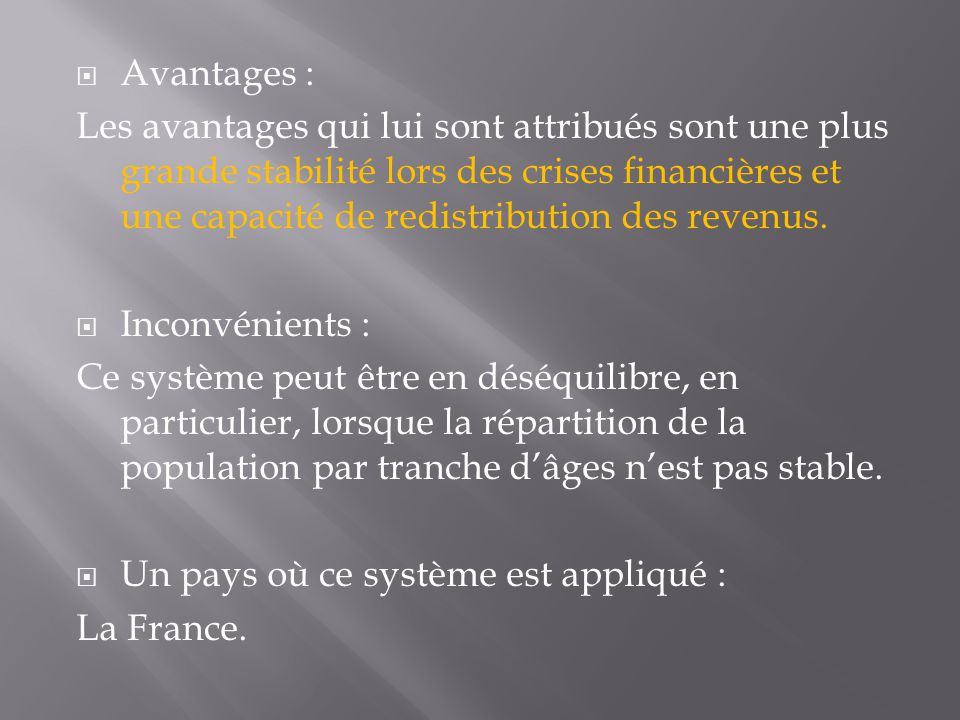The pay-as-you-go pension system is a hotly debated topic in France. While it offers advantages such as intergenerational solidarity and wealth redistribution, it is not without drawbacks such as dependence on demographics and the resulting deficits. In this article, we analyze benefits and constraints of this crucial system for our seniors.
The advantages and disadvantages of the pay-as-you-go pension system.
The pay-as-you-go pension system was set up to provide a pension for all French workers. Contributions are deducted from the salaries of working people and redistributed to retirees. This method has both advantages and disadvantages.
The advantages of the pay-as-you-go pension system :
Firstly, the pay-as-you-go system guarantees a pension to all retirees, regardless of socio-professional category or income level. It is therefore a solidarity-based system that protects the weakest workers.
Secondly, the system is managed collectively and transparently by public institutions. So everyone can have confidence in the system's efficiency and expect a decent pension.
The disadvantages of the pay-as-you-go pension system :
Firstly, the system is based on maintaining a demographic balance. If the working population falls while the retired population rises, it will become increasingly difficult to finance the pension. There is therefore every reason to fear that pensions will fall in the future.
What's more, wealthier workers tend to contribute more than their final use of benefits, while the less well-off contribute less than their actual needs. This can lead to inequalities in the pension system.
In conclusion, the pay-as-you-go pension system has undeniable advantages in terms of solidarity and transparency. But it remains fragile, as it is based on a precarious demographic balance and can give rise to inequalities between workers.
My retirement in exile | Temps Présent
[arve url="https://www.youtube.com/embed/C6dm9JO8hiA "/]
Pension reform: why the French system is so complex
[arve url="https://www.youtube.com/embed/Cb6SIBCAJJ4″/]
What are the benefits of the pay-as-you-go pension system?
The pay-as-you-go pension system offers several important benefits for workers and society in general. First and foremost, it ensures a fairer redistribution of wealthby guaranteeing all pensioners a certain level of income, regardless of their profession or social status. In addition, it provides essential social protection for workers throughout their working livesThis is achieved by guaranteeing them rights and benefits that enable them to cope with the hazards of life (illness, accident, unemployment, etc.).
What's more, the pay-as-you-go pension system is a key factor in intergenerational solidarityIn this way, we maintain a balance between the different generations, ensuring that the elderly are not left to fend for themselves. This helps to maintain a balance between the different generations, preventing the elderly from being left to their own devices and enabling the younger generations to benefit from a sustainable social protection system.
Finally, the pay-as-you-go pension system is an essential pillar of the social contract between the State and its citizensIt guarantees a minimum level of support for the elderly, thereby helping to maintain strong social cohesion. Thanks to this system, pensioners can continue to live with dignity and play an active part in the social, economic and cultural life of their country.
What's the main problem with pay-as-you-go pensions?
The main problem with the pay-as-you-go pension system is its long-term financial sustainability. This system is based on the principle of intergenerational solidarity, whereby contributions from working people finance the pensions of retired people. However, as the population ages and the number of workers declines, it is becoming increasingly difficult to maintain an adequate level of funding for pensions.
In additionHowever, pay-as-you-go can be influenced by demographic, economic and political factors, which can lead to imbalances in the system. For example, an economic recession may reduce contribution income, while rising life expectancy may increase pension expenditure.
FinallyHowever, some critics argue that pay-as-you-go creates intergenerational injustice, as the contributions of current workers fund the pensions of current retirees, to the detriment of future generations who will not have access to the same level of funding.
In short, although the pay-as-you-go system has been an important pillar of the French pension system for many years, there are still a number of issues that need to be addressed. reforms are necessary to ensure long-term financial viability and intergenerational equity.
What's the best pension plan?
The optimal retirement plan depends on factors such as age, salary, length of employment and personal preferences. In France, there are two main pension schemes: the Assurance Retraite general scheme and the Arrco-Agirc supplementary system. The general scheme is compulsory for all French workers, and provides a basic pension calculated on the basis of contributions paid throughout one's professional career. The complementary Arrco-Agirc system, on the other hand, is optional and provides an additional pension over and above that provided by the general scheme.
For the self-employed and the liberal professions, the optimal retirement scheme may be different. They can opt for the Social Regime for the Self-Employed (Régime Social des Indépendants - RSI), which offers comprehensive social security coverage and a specific pension scheme. There are also specific supplementary pension schemes for certain professions, such as lawyers, notaries and doctors.
It's important for every worker to consult a wealth management advisor or retirement expert to determine the most optimal retirement plan for his or her personal situation. Retirement planning choices can have a significant impact on long-term personal finances, and need to be taken with care.
What's the difference between funded and pay-as-you-go pensions?
Visit funded pension is a system whereby each worker contributes to a pension fund or life insurance policy, which invests its funds to generate profits. At the end of their working life, workers receive a pension proportional to their accumulated capital and the profitability of their investments.
On the other hand, the pay-as-you-go pension operates on the principle of solidarity between generations within a single social security system. Workers contribute during their careers, and thus finance the pensions of current retirees. When they reach retirement age, subsequent workers finance their pensions.
There are advantages and disadvantages to each pension system. The main advantage of funded pensions is that contributions are invested and can generate higher profits. This can eventually result in a higher pension than that offered by pay-as-you-go. However, this is not without risk, as investment returns can vary and contributions do not always accumulate sufficient capital for a comfortable retirement.
Pay-as-you-go pensions offer protection against the uncertainty of the financial market, and guarantee a minimum pension even for those with short careers or low incomes. However, there are also disadvantages, such as the risk of having the pension reduced due to an imbalance between contributions and benefits, or dependence on the national economy.
Ultimately, the choice of pension system depends on the priorities and values of each country and its citizens.
What are the advantages and disadvantages of France's pay-as-you-go pension system?
Advantages of France's pay-as-you-go pension system :
- Intergenerational solidarity: working people's contributions finance retirees' pensions, enabling a redistribution of wealth and care for the most vulnerable.
- Income stability: the State's commitment to guaranteeing a minimum standard of living for retirees ensures a degree of financial security for the beneficiaries of the pension system.
- Recognition of arduous working conditions: certain occupational categories are eligible for early retirement to take account of difficult working conditions or exposure to occupational hazards.
Disadvantages of France's pay-as-you-go pension system :
- Demographic imbalance: the aging of the population is leading to an increase in the number of pensioners and a decrease in the number of working people, thus jeopardizing the system's financial equilibrium.
- Rigidity of the system: age and contribution rules are uniform and not adapted to individual situations, which can be disadvantageous for some.
- Dependence on public funding: the system's deficits and financial imbalances force the government to finance a significant proportion of retirement pensions, increasing the tax burden on working people.
In conclusion, France's pay-as-you-go pension system is based on solidarity and protection, but is facing demographic and financial difficulties. Structural reforms are needed to ensure the long-term viability and fairness of this system.
How does the pay-as-you-go pension system work, and what are its main benefits for workers?
The pay-as-you-go pension system is one in which contributions from working people finance the pensions paid to retirees. In France, this system is managed by the Social Security system and operates on the principle of intergenerational solidarity.
The main advantages of this system for workers are :
1. Financial security: Contributions paid throughout a working life guarantee a retirement pension at the end of a career. This enables workers to plan their financial future in complete security.
2. Intergenerational solidarity: The pay-as-you-go pension system enables working people to finance the pensions of retired people. This intergenerational solidarity ensures that everyone can enjoy a decent retirement, whatever their financial situation.
3. Administrative simplicity: The pay-as-you-go pension system is managed by the French Social Security system, and therefore requires no complex administrative formalities for workers.
In short, the pay-as-you-go pension system is a supportive and reassuring system that enables workers to enjoy a decent retirement pension at the end of their working career.
What are the alternatives to the pay-as-you-go pension system, and what are the consequences in terms of advantages and disadvantages for workers?
The pay-as-you-go pension system is one in which pensions are financed by contributions from active employees. However, there are alternatives to this system, such as :
1. The funded pension system : In this system, each employee contributes to his or her own pension, and these contributions are invested in the financial markets. Pensions therefore depend on the return on these investments. This system has the advantage of being more flexible and individualized, but it exposes workers to financial risks.
2. The mixed system : This system combines the two previous systems, offering employees the option of contributing to both a pay-as-you-go and a funded pension scheme. This combines the advantages of both systems and limits their respective disadvantages.
The consequences of these alternatives in terms of advantages and disadvantages for workers are as follows:
For the funded pension system : workers have greater freedom of choice when it comes to managing their savings, and can benefit from higher returns. However, they are also exposed to financial risks, such as stock market fluctuations, which can affect their pension levels.
For the mixed system : workers benefit from the advantages of both systems, i.e. the minimum social protection guaranteed by the pay-as-you-go pension scheme and the greater flexibility offered by the funded pension scheme. However, this can also lead to additional costs for workers and difficulties in managing their savings.
Ultimately, the choice between these different alternatives will depend on workers' priorities and specific needs. Each system has its advantages and disadvantages, and it's important to evaluate them carefully before making a decision.
In short, the pay-as-you-go pension system has its advantages, such as intergenerational solidarity and financial security for low-income earners. However, it also has its drawbacks, including long-term dependence on economic growth, the possibility of insolvency and potential mismanagement of funds. It is therefore important for governments to implement appropriate reforms to ensure the long-term sustainability of this system. Workers should also be aware of the limitations of pay-as-you-go pensions, and start planning their own retirement as soon as possible. Ultimately, the choice of retirement system depends on individual preferences and retirement goals.








